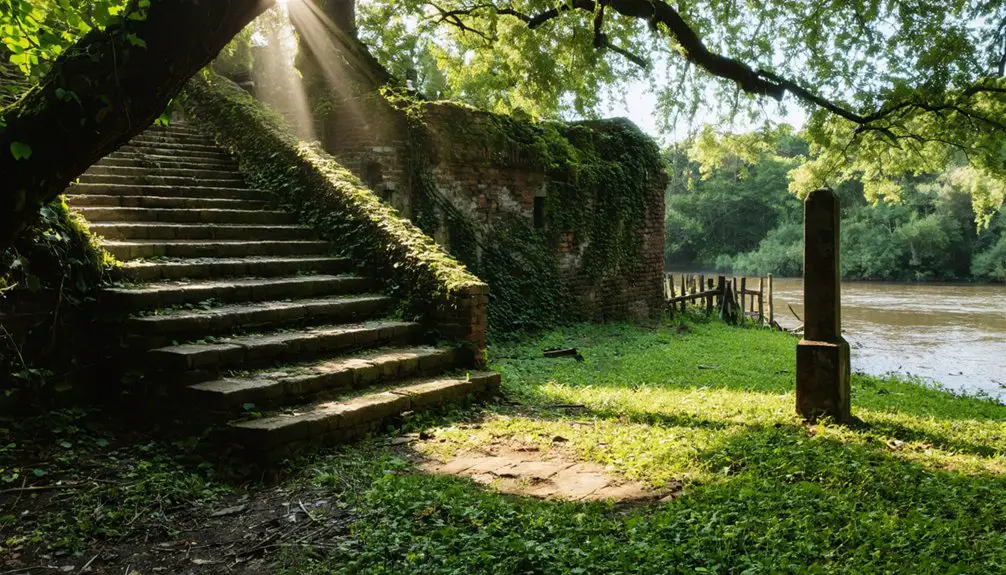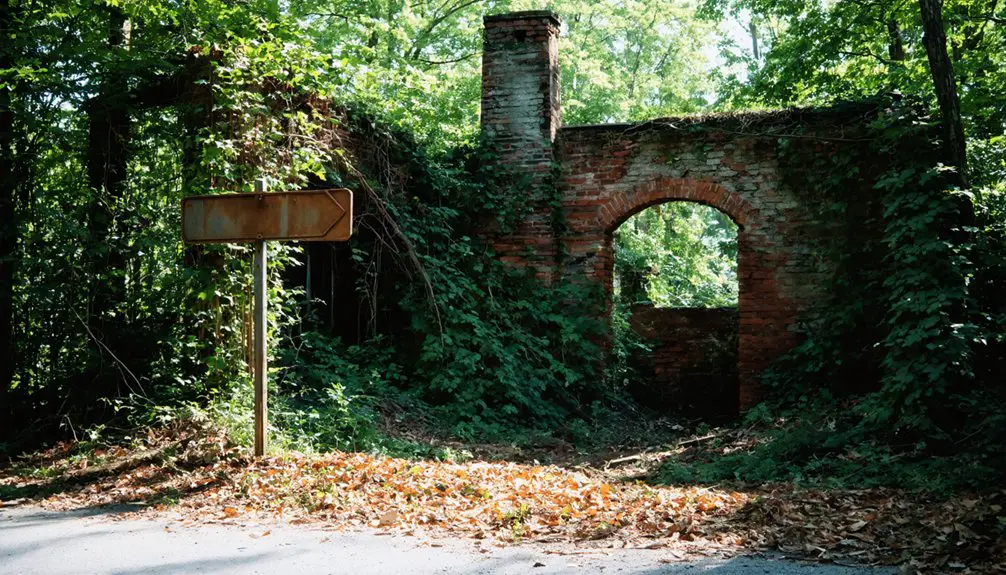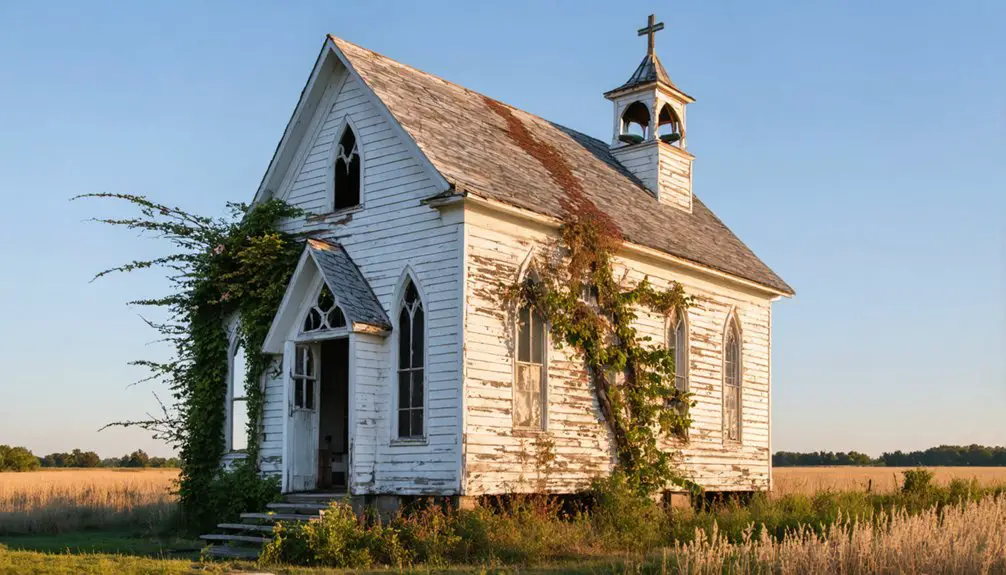You’ll discover Logtown’s haunting story along Mississippi’s Pearl River, where a bustling lumber empire once thrived. Founded in 1845, this industrial powerhouse employed 1,200 workers and grew to 3,000 residents by 1918. NASA’s arrival in 1961 forced the complete evacuation of the town, leaving only concrete foundations, family cemeteries, and the 3.1-mile Possum Walk Heritage Trail. The preserved remnants and markers hold countless untold tales of this vanished community.
Key Takeaways
- Logtown, Mississippi was a thriving lumber town with 3,000 residents until NASA acquired the land in 1961 for rocket testing.
- The town was completely cleared to establish a 125,000-acre buffer zone for the Stennis Space Center operations.
- Physical remnants include three family cemeteries, concrete foundations, and brick structures along the Pearl River.
- The Possum Walk Heritage Trail allows visitors to explore the ghost town’s historical sites and natural environment.
- Originally established as Cabanage Latanier in 1788, Logtown became a major lumber production center under Henry Weston’s operations.
The Rise of a Lumber Empire
While many 18th-century settlers initially established Logtown as “Cabanage Latanier,” the community’s true destiny emerged in 1845 when E. G. Goddard from Michigan established the first sawmill.
You’ll find that early settlers quickly recognized the region’s wealth of high-quality timber, including cypress, live oak, cedar, mulberry, and locust along the rivers.
The turning point came in 1889 when Henry Weston founded what would become America’s largest lumber production empire.
His company revolutionized timber processing with an impressive operation of 1,200 workers, over 20 barges, and four two-masted schooners.
By 1918, you’d have seen massive log stacks, sawmills, and drying kilns lining the Pearl River’s banks.
The bustling operation supported a thriving community of more than 3,000 people, transforming Logtown into southern Mississippi’s industrial powerhouse.
The Pearl River’s navigable waters enabled efficient transportation of lumber to major ports like New Orleans and Mobile.
The town flourished with various local businesses, including grocery stores, hardware stores, drugstores, a bank, and even a movie theater.
Life Along the Pearl River
You’ll find that life along the Pearl River centered around a bustling trade network, where lumber barges and fishing vessels created constant waterfront activity at Logtown’s docks.
Local fishermen cast their nets daily in the blackwater river’s depths, supplying fresh catches to both riverside communities and distant markets. The river’s strategic location as a 115-mile boundary between Mississippi and Louisiana made it an ideal transportation corridor. The Pearl River stretches 411 miles long from east-central Mississippi to the Gulf of Mexico.
The waterfront hummed with activity as workers loaded timber onto steamboats, while others maintained fishing equipment, repaired vessels, and conducted the daily business of a thriving river port.
River Trade and Commerce
During the mid-1800s, the Pearl River emerged as an essential commercial artery connecting Mississippi’s interior to the Gulf Coast, with steamboat traffic revolutionizing trade between New Orleans and Jackson.
You’d find steamboats like the Choctaw and Alice Maria maneuvering these waters, carrying timber, cotton, and supplies to growing riverside communities. The river transport system transformed towns like Logtown into significant commerce hubs, where Sea Island cotton fetched premium prices and lumber flowed freely to distant markets. In 1835, Captain James Latham announced regular steamboat service on the Pearl River. The Weston sawmill in Logtown became the world’s largest, processing vast amounts of pine and cypress for export.
- Steamers visited river towns twice weekly, carrying mail and passengers while serving as floating grocery stores.
- Northern investors poured money into virgin timber tracts, capitalizing on the Pearl’s natural highway.
- Cotton yields reached 800 pounds per acre, with shipments earning up to 44 cents per pound in New Orleans.
Fishing Community Thrives
Life along the Pearl River pulsed with the rhythms of a vibrant fishing community, where families gathered daily to cast their lines into the rich waters.
You’d find locals sharing their favorite fishing techniques along the riverbank, creating an atmosphere where practical sustenance merged seamlessly with cultural tradition.
These community gatherings weren’t just about the catch – they served as informal meeting spaces where generations exchanged stories and strengthened bonds.
The river’s ecosystem, rich with native fish species and bordered by pine and hardwood forests, provided both food security and a natural backdrop for social connection.
You’ll appreciate how this lifestyle fostered independence, as families relied on their own skills while participating in a broader network of river-based cultural exchange and shared resources.
For enhanced navigation accuracy, locals often needed to specify which Logtown they were referring to when discussing locations along the Pearl River.
The lumber industry growth transformed the landscape along the riverbanks, impacting both the natural environment and the local economy in significant ways.
Waterfront Daily Activities
Along the bustling waterfront of Logtown, daily activities revolved around the Pearl River‘s essential presence, where steamboats docked twice weekly to facilitate trade and local commerce.
You’d find workers bustling around the Weston sawmill while families enjoyed recreational fishing spots beneath moss-draped trees. The waterfront gatherings brought the community together, with locals meeting at park-like settings along the riverbank.
- Visit the large commissary near the water’s edge, where you could purchase everything from fashionable hats to practical necessities.
- Explore the ferry crossings and steamboat landings that connected you to nearby towns like Edinburg and Carthage.
- Enjoy the social atmosphere of the swimming pool and hotel, where both residents and visitors gathered to escape the Southern heat.
NASA’s Arrival and Community Displacement
When NASA selected Hancock County, Mississippi as the site for rocket engine testing in October 1961, the decision would forever alter the region’s landscape and displace hundreds of families.
You’ll find that NASA’s arrival meant the complete clearing of five small towns—Gainesville, Logtown, Napoleon, Santa Rosa, and Westonia—along with part of Pearlington, leading to profound cultural displacement.
The U.S. Army Corps of Engineers acquired over 3,200 parcels, including 786 homes, 16 churches, 19 stores, and 3 schools. The government needed high-terrace area land bordering the East Pearl River for its strategic location.
NASA needed the land for their test facility and a massive 125,000-acre buffer zone to shield residents from rocket testing noise.
While the space program brought new opportunities to the region, community memories of this forced relocation survive through poems and stories passed down by displaced residents’ descendants.
What Remains Today

Today you’ll find Logtown’s physical remnants scattered throughout the forested landscape, including three historic family cemeteries dating to the 1850s and concrete foundations along the Pearl River’s edge.
Like many abandoned settlements, Logtown faced government expropriation when the area was acquired for NASA’s testing facilities.
You can explore these ghostly traces of the past along the 3-mile Possum Walk Trail, which connects the NASA Infinity Science Center to the former town site and features interpretive signs about Logtown’s history.
While most of the original structures have vanished, leaving only ruins beneath encroaching vegetation, these preserved elements offer tangible connections to the community that once thrived here.
Physical Ruins and Remnants
Despite its abandonment decades ago, Logtown’s physical remnants offer tangible connections to Mississippi’s industrial past.
You’ll find three private family cemeteries dating to the 1850s, serving as vital markers of cemetery preservation. Along the Pearl River, scattered architectural remnants reveal the town’s industrial footprint through concrete and brick foundations, while the Possum Walk Trail guides you through 3 miles of history.
- Explore the historic cemeteries, where generations of Logtown residents rest undisturbed
- Discover building foundations along the riverbank that outline the former lumber town
- Follow the trail system featuring remnants of the old Dummy Line railroad and interpretive markers
These preserved elements, protected within NASA’s buffer zone, continue to tell Logtown’s story despite nature’s gradual reclamation of the land.
Historical Trails and Markers
Through thoughtfully designed trail networks and interpretive markers, Logtown’s rich history comes alive along the 3.1-mile Possum Walk Heritage Trail.
You’ll discover boardwalks spanning Bayou Bogue Homa, leading you through pine forests and swamplands where historical markers reveal the community’s cultural heritage at every turn.
As you explore, you’ll encounter signs detailing Logtown’s historical significance, from Prohibition-era moonshine operations to the vibrant social life of “the Point,” an African-American settlement.
The trail connects you to three family cemeteries dating to the 1850s and remnants of the old Dummy Line railroad.
For a different perspective, you can access the Logtown Blueway via kayak launch, offering water-based exploration of the bayou and Pearl River system.
Walking the Possum Walk Trail
While exploring Mississippi’s rich cultural heritage, you’ll discover the Possum Walk Trail – a 3.1 to 3.7-mile route connecting the historic Logtown Cemetery to the INFINITY Science Center near the Pearl River.
Experience Mississippi’s past along the scenic Possum Walk Trail, linking the historic Logtown Cemetery with the modern INFINITY Science Center.
As you traverse this nature trail, you’ll cross Bayou Bogue Homa via a bridge and navigate boardwalks through pine woods and swamps. Historical markers along the path reveal stories of former communities, including the African-American settlement of Possum Walk and the bustling lumber town of Logtown.
- Plan your visit between spring and fall, as the trail closes from November to February for hunting season
- Take advantage of the eco-friendly electric tram for a 6-mile nature tour lasting about 45 minutes
- Stop at interpretive signs highlighting native wildlife, plants, and the cultural heritage of displaced communities
Legacy of a Lost Mississippi Town

The rich history of Logtown began in 1788 when Jean Baptiste Rousseve established a homestead on his 1,000-arpen land grant, then known as Cabanage Latanier or “palmetto camp.”
Strategically positioned at the mouth of the Pearl River, this settlement evolved from a modest homestead into a thriving lumber town after E.G. Goddard built the first sawmill in 1845.
Today, you’ll find remnants of community resilience in the preserved cemeteries dating back to the 1850s, concrete foundations, and artesian wells.
Though the town was evacuated for the Stennis Space Center in 1961, Logtown’s cultural heritage lives on through historical markers and interpretive signs along hiking trails.
The Dummy Line railroad remnants and surviving structures stand as silent witnesses to a once-bustling community that exemplified both industrial prosperity and the harsh realities of resource depletion.
Frequently Asked Questions
Are There Any Ghost Stories or Supernatural Legends Associated With Logtown?
Since the 1960s exodus of 250+ residents, you’ll find haunted tales centered on three historic cemeteries and abandoned ruins, though documented ghost sightings remain anecdotal rather than officially verified.
What Kind of Wildlife Can Be Found in the Former Logtown Area Today?
You’ll encounter diverse wildlife sightings along Pearl River, from white-tailed deer and bobcats to waterfowl and songbirds. Local species include raccoons, opossums, and various reptiles in wetland areas.
Did Any Famous People or Notable Historical Figures Come From Logtown?
Like a quiet bayou, Logtown didn’t spawn headline-grabbing celebrities. You’ll find its historical significance centered on lumber pioneers like Henry Weston and E.G. Goddard rather than famous residents.
What Was the Average Income of Logtown Residents During Its Peak?
You’d find average wages during peak operations ranged from $300-$600 annually, varying by skill level, though exact figures aren’t documented. The economic decline after 1930 drastically reduced incomes.
Were There Any Major Natural Disasters That Affected Logtown Before NASA Arrived?
Like a whisper in time’s corridors, you won’t find records of major natural disasters striking before NASA’s arrival. Historical impact mainly came from yellow fever outbreaks in 1878, not devastating storms.
References
- https://www.youtube.com/watch?v=n-pwtBwbqUE
- https://www.loquis.com/en/loquis/6666594/Logtown+Mississippi
- https://www.instagram.com/p/DI9FkP7Nw4u/
- https://en.wikipedia.org/wiki/Logtown
- https://www.tiktok.com/@mississippi_kween/video/7046116659878186286
- https://kids.kiddle.co/Logtown
- https://www.hancockcountyhistoricalsociety.com/history/lumbering-in-hancock-county
- https://www.msrailroads.com/Towns/Logtown.htm
- http://sites.rootsweb.com/~lalgs/henryweston.htm
- https://en.wikipedia.org/wiki/Pearl_River_(Mississippi–Louisiana)



